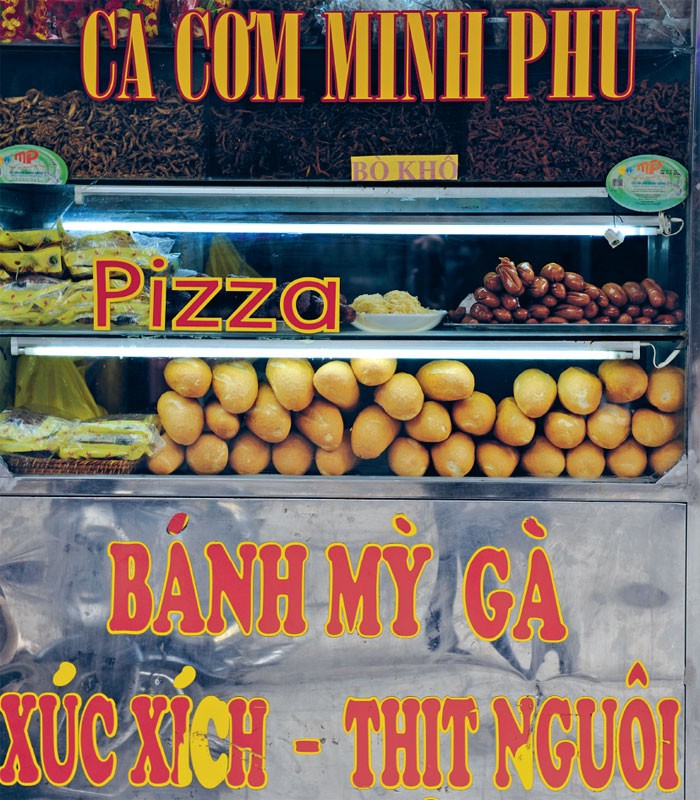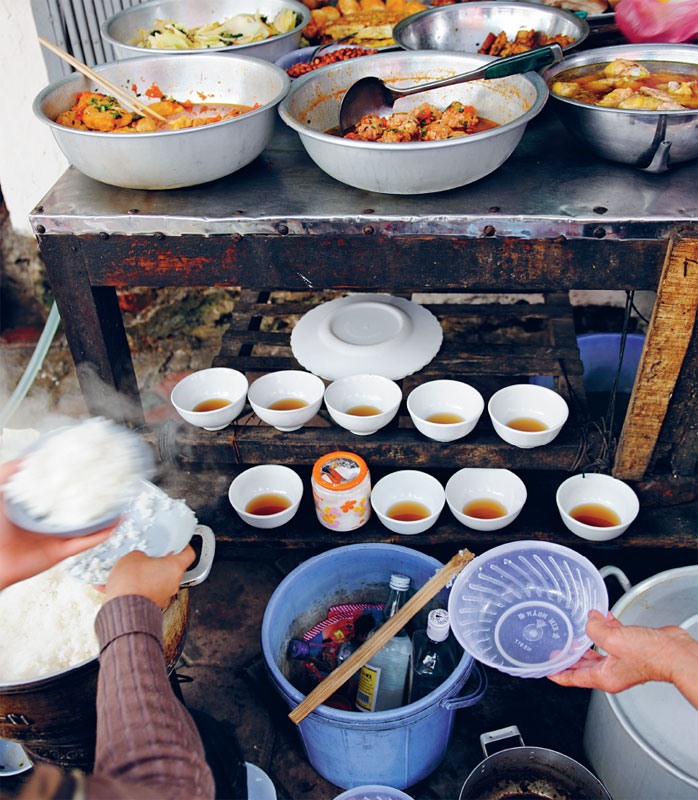

It is still dark when Ms Thuy sets up her stall on the unpaved roadside opposite a lane that leads to a high-rise of serviced apartments for well-to-do expatriates and locals. Not much is needed to get the stall going: a charcoal burner, a tarpaulin strung up with the help of two bamboo poles, a trestle table on which the food is laid out, and an assortment of blue plastic stools.
At early light the first customers start to drift in. People on their way to work or coming off night shift stop by for a quick bite to eat. Hunched over their bowls, they enjoy the company of fellow diners, or some quick banter with the proprietor or the bicycle repairmen next to the stall. By 10 o’clock it’s all over and everything is being packed up to make way for the tea stall that has the spot for the rest of the day.
It is often said that life in Vietnam happens on the streets. This is particularly true in the overcrowded inner cities, where it sometimes seems that the Vietnamese conduct their daily life, if not exclusively on the sidewalk, then in plain view of the streets, throwing the doors to their living rooms open to the footpath. The strict division between public and private spheres is blurred when people wash their hair, clean dishes, conduct business or catch up with friends on the pavements of the cities. Eating on the street also plays an important part in daily life.
Com Bui – Dust Meals
Everywhere, something is cooking, steaming or frying in pots, pans and woks on burners fuelled by lumps of honeycomb-like coal, delivered on impossibly overloaded bicycles.
The Vietnamese version of alfresco dining is such a natural extension of street life, so widespread and common, that it is easy to overlook how fairly recent the phenomenon of the so-called com bui, literally ‘dust meals’, really is.
Traditionally, family meals at home were sacred, but historical upheavals and changes in work practices created an eating culture with roving food vendors and street stalls to feed the hungry masses away from their houses. The wars for national independence against the French and the Americans from 1945 to 1975 displaced scores of people, and the Doi Moi policies of economic renewal at the end of the 1980s introduced modern work practices that meant longer hours and often greater distances between home and work. These changes revolutionised not only the way the country was run, but also the way the country ate.
Still, there is more to the popularity of com bui than politics and economics – kerbside dining fits Vietnam’s collectivist culture of doing things together. Eating alone is frowned upon, so much so that the Vietnamese have coined a saying, ‘an mot minh dau tuc’, which literally means ‘eating alone is painful’. Luckily, squeezing in at a communal table on low stools or wobbly child-size plastic chairs, close to the street life and the traffic, is the very opposite of private dining. Even if one eats alone, one isn’t lonely, but connected to fellow diners and the surrounding community.
The shift from eating at home or in more up-market restaurants to casual kerbside dining also marks a transition from a feudal, class-ridden society to a more equal one – a new society, where peasants and public servants, students and shop owners can share a bench and slurp their noodle soups side by side.
Making a Living on the Street
The huge social changes Vietnam went through in the last century were a great leveller in more ways than one. The social and economic pressures fuelled the popularity of, and necessity for, street food. By the same token, though, hard times forced many a family, as a popular Vietnamese proverb goes, ‘to make one’s living on the street’. Devoid of any red-light-district connotations, it refers to supplementing the household income by running a small business where all family members can pitch in: a shop out of the front room, a tea stall on the pavement, or a food stall.
The advent of street food might have been closely related to the long struggle for independence, but after the end of what the Vietnamese call the American War, street food culture faced significant difficulties. Food was in short supply and was rationed during the bao cap or so-called ‘subsidised period’, which lasted well into the 1980s. During that time, the government put tight restrictions on operating small businesses. However, food stalls carried on, flying under the radar of the authorities, often operating out of private homes or with restricted trading hours. Soon after the introduction of economic reforms in 1986, the street food scene blossomed again and the whole range of culinary delights returned to the city pavements.
For many vendors, a cherished family recipe became the springboard into the hospitality industry. And while it is mostly the women who take the plunge into opening their own businesses, family recipes are rarely passed on to the daughters. Instead it is the daughter-in-law who commonly benefits from learning the kitchen secrets. This is particularly true in the more traditional country areas. Since women usually move in with their husbands’ families, who might even live in different villages or towns, withholding recipes is an effective form of ‘copyright protection’, ensuring the culinary knowledge stays strictly within the one family.
Com Binh Dan and One-dish Joints
The fondness for kerbside dining gave rise to new kinds of eateries.
At one end of the spectrum is the com binh dan (literally, ‘food for the working people’), probably best described as a Vietnamese lunch buffet. At these eateries, staff heap mounds of steamed rice onto plates. Diners then select what they would like to have piled on top of the rice, usually choosing from a dozen or more trays of pre-prepared dishes. The cost of the meal depends on what and how much was ordered. Food choices range from the very simple, such as roasted, salted peanuts or the ubiquitous xao mong (sautéed water spinach), to more elaborate fare such as fish in caramel sauce and beef in betel leaf. It pays to arrive early, as com binh dan eateries often run out of the more popular dishes. Also, there are usually no bain-maries, thus an early lunch means a warm lunch.
While the com binh dan is all about choice, the restaurants at the other end of the spectrum offer none whatsoever. There is no lingering over trays of food, no procrastination over what to order, no discussions with the proprietor over the day’s special. These eateries prepare one dish, and one dish only.
One of the most famous of these kind of eateries is Cha Ca La Vong in Hanoi, which has evolved from its humble street food beginnings at the end of the 19th century into a small restaurant and a Hanoi institution. It is so famous, it even gave its name to the street on which it is located. The only dish that has ever been served in Cha Ca La Vong’s long history is pan-fried Red River fish with turmeric, dill and peanuts on cold vermicelli noodles. The current proprietor, Ms Loc, is rumoured to be the only person who knows the secret recipe for the unique turmeric marinade, which she learned from her mother-in-law in the early 1970s.
Location, Location, Location
Although food stalls can be found on virtually every street corner, location still matters. Convenience counts, as only a few places become well known enough for street food connoisseurs to go out of their way in search of the perfect pho or bun cha. The areas around markets are always street food hubs, close to vital ingredients and a steady stream of customers, hungry from hours of tough bargaining. Office areas are also popular, particularly for com binh dan eateries in the lanes off the main thoroughfares. Itinerant vendors set up close to their customers: sweets near schools or hearty after-work snacks near bus stops.
The street food culture is under threat from a push to gentrify and modernise neighbourhoods. Culinary reality, though, often barely keeps pace with the brave new world of bureaucratic rules and regulations. In theory, for example, meat should only be transported in refrigerated vans. In practice, hardly any of the small butcher shops can afford such a luxury. A freshly butchered pig’s carcass slung over a motorbike on the way to the market continues to be a common sight, providing countless photographic opportunities for visitors and, for locals, the reassurance that the old ways of doing things might not change that quickly after all.
To combat traffic congestion and to tidy up the chaos of street stalls, parked motorbikes, and shop merchandise spilling onto the footpath, local authorities have declared some larger thoroughfares ‘model streets’ and are cracking down on roving street vendors. One such area is the so-called ‘international bia hoi corner’ in Hanoi’s old quarter: a busy intersection with street-side watering holes selling cheap fresh beer. Rather than being driven away from their beer-drinking customers, the women selling the chargrilled dried squid elect to play cat and mouse with the police. Warned of police patrols by punters or the bia hoi proprietors themselves, they quickly pack up their small braziers, plastic plates and bags of dried cuttlefish and disappear into the dark lanes, only to reemerge once the threat to their livelihood has passed. In most areas, though, the old Vietnamese proverb ‘phep vua thua le lang’ (‘The King’s rule has to yield to the village custom’) continues to apply. In practice, this means that it is the occupant of the house who determines what can and cannot happen on the pavement in front of it – like subletting a space that is, strictly speaking, public property. The custom appears to be tolerated by the authorities, and a whole range of arrangements is in place, from street sellers being simply accepted at certain times of the day, to more formal ‘rental’ agreements.
The push for gentrification and squabbles over the use of sidewalks drive many vendors away from the main streets into smaller alleyways. Although it might be more difficult to seek out specific stalls, a stroll through the mazes of alleys and lanes often ends up being a journey of discovery leading to more memorable meals in more picturesque surroundings than the main street would ever be able to offer.
Pho, Glorious Pho
Street food also satisfies another aspect of Vietnamese culinary culture: a fondness for grazing, for eating smaller dishes and snacks throughout the day instead of a couple of big meals at set times. Street stalls have very specific trading hours, and roving vendors often only set up during the best times for their specialty. While there is an extensive range of meals, snacks and treats to explore, and regional differences to discover, certain classics stand out. The most famous, undoubtedly, is pho (noodle soup), the quintessential Hanoi street food and, in the words of the venerable scholar, Huu Ngoc, no less than ‘Vietnam’s contribution to human happiness’. Pho is treated as a national treasure, so much so that the soup even warranted a conference some years ago, covering the social, culinary and historical aspects of the dish.
The origins of pho are shrouded in mystery. It seems that it was invented in the early 20th century in the province of Nam Dinh, which was then a centre of the French colonial textile industry. One theory contends that it was a blend of French (beef) and Vietnamese (noodles) influences. Another claims that the name pho was chosen as a phonetic imitation of the French word feu, as in pot-aufeu. From a strictly linguistic point of view, pho is the name of the rice noodles used in the soup, but the word stuck as shorthand for the entire dish. What seems certain is that the impoverished village of Van Cu is the epicentre from which pho started its victory march to street food glory. The first documented villager to move to Hanoi to earn a living as a pho vendor was a Mr Van in 1925. Many more were to follow in his footsteps, particularly after the end of World War II when the dish started to grow in popularity.


Pho started out as a beef soup in three basic varieties: with slices of boiled and air-dried beef (pho bo chin), with thin slices of rare beef (pho bo tai) or a mixture of both (pho bo tai nam). Pho with chicken (pho ga) was initially considered a soup for women and children, and before 1945 only one stall in Hanoi made pho ga. It only became more widespread in the years immediately after the Japanese occupation of Vietnam and then again during the bao cap era — both times in which beef was hard to come by. Nowadays, the soup is a well-loved alternative to the heavy pho bo, particularly during the oppressive heat of summer. Although pho is originally a northern dish, it has been adopted by the south and the recipes changed in the process. In Ho Chi Minh City, pho is served in bigger bowls with more herbs and other condiments, a custom considered vulgar by many of the northern pho purists.
Bread and Noodles
Pho might be the most famous street food, but hot on its heels in the popularity stakes is another street eats treat, bun cha: chargrilled pork patties floating in a tangy dipping sauce, served with cold vermicelli (bun) and an assortment of herbs and salad leaves. It is often served with nem ran, fried spring rolls, on a separate plate.
Eating bun cha can test the chopstick skills of the Western diner: using the implements to make a lettuce leaf parcel with vermicelli, meat and herbs to dip into broth takes some practice. If that is too fiddly, a mouthful of vermicelli and meat, followed by a lettuce or herb leaf, will also do the trick.
While pho is traditionally a breakfast or early dinner, bun cha firmly occupies the lunchtime slot, and it is the enticing aroma of the grilled pork that lures in the diners. The writer Thach Lam (1909–1942), who penned one of the first books on Vietnamese food, Delicious Hanoi Food, even went so far as to claim that a whiff of the delicious smell of the marinated pork being grilled would be enough to make the ill rise from their sick beds.
For a change from rice noodles, one doesn’t have to look far. The French left Vietnam in 1954 after being defeated by the Viet Minh in the northern mountain town of Dien Bien Phu, but they left behind an enduring love for fresh, crusty baguettes, banh mi. As with most foreign food, the Vietnamese adapted the original recipe to suit their tastes. Here, baguettes are made from a wheat and rice flour mixture, which results in a very airy bread that has a thin crisp crust and looks like an oversized, oblong roll.
The bread is peddled by roving street vendors carrying bamboo baskets covered with hessian sacks to keep the baguettes warm, or from street stalls, where they are artfully arranged into pyramids.
The local version of the sandwich has a firm foothold in the local street food culture. Vietnamese—American author Monique Truong (The Book of Salt) has called it ‘the ultimate on-the-go fare’. Only fitting, then, that banh mi is particularly popular in fast-paced Ho Chi Minh City, where vendors cram them full of delicious fillings, ranging from a whole array of cold meats, to omelette and fish patties, all spiced with pickles, fish sauce and chilli.
The latest addition to the banh mi family is a culinary nomad: the doner kebab. Originally imported to Germany by guest workers from Turkey, it was brought to Vietnam by chef Tran Minh Ngoc, who worked in Augsburg in the late 1990s. Ngoc opened his first kebab grill in 2005 in front of the German cultural institute in Hanoi and over the last few years, the doner kebab has become the fastest growing street food in the city, with carts popping up everywhere. But Vietnam wouldn’t be Vietnam if it didn’t put its own spin on the Middle Eastern staple: the banh mi is made with grilled pork instead of halal lamb and might even come with a dash of fish sauce.
Fast Food Nation
Late arrivals, like the kebab, notwithstanding, the street eats game is inherently conservative. It’s about tradition, not experimentation. It is about dishes that have been perfected over years and even decades, and which are not to be tampered with.
Vietnamese street food culture remains a bastion of cultural identity against culinary globalisation. Despite the advent of food chains in Ho Chi Minh City and Hanoi, and the disappearance of the traditional wet markets, stalls on every corner continue to offer the uniquely Vietnamese version of fast food: cheap and cheerful, fresh and nutritious, seasonal and local, for a people perpetually on the move.
